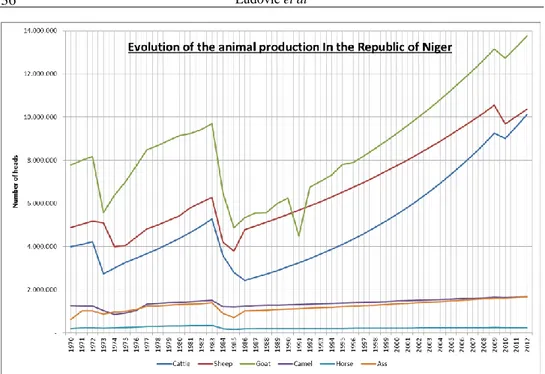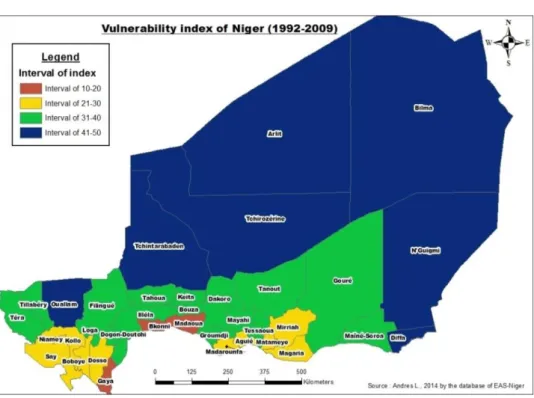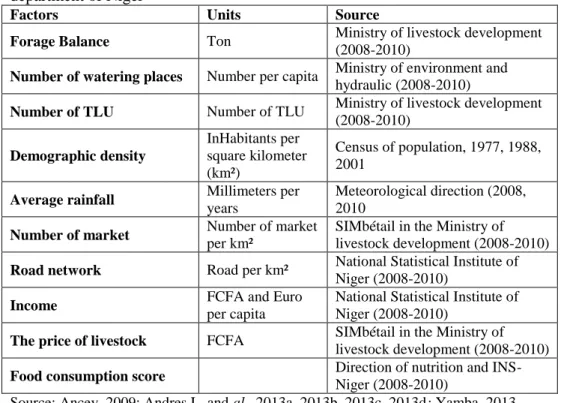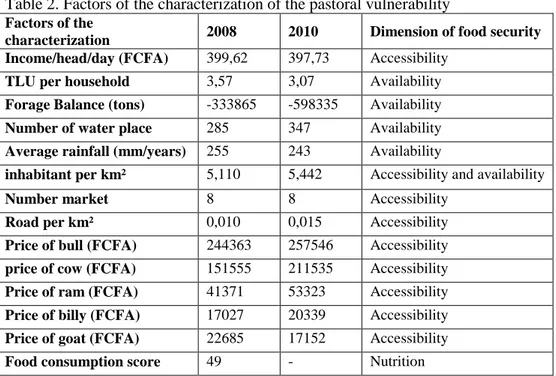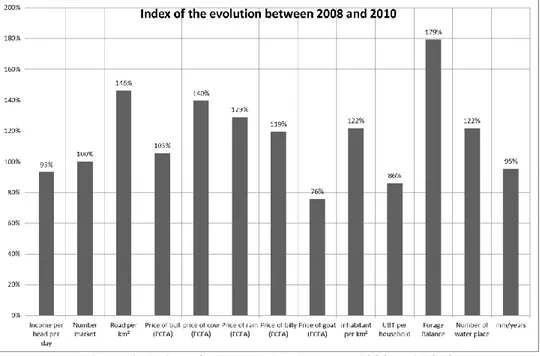Agriculture & Forestry, Vol. 60 Issue 4: 35-42, 2014, Podgorica 35
UDC 636(669 Niger)
Andres LUDOVIC, Bodé SAMBO, Du Faux JUDITH,
Abdoulkadri LAOUALI, Yamba BOUBACAR, Lebailly PHILIPPE 1
A PROPOSAL OF A VULNERABILITY INDEX IN THE PASTORAL FOOD SYSTEM IN THE REPUBLIC OF NIGER:
CASE OF THE DEPARTMENT OF ABALAK SUMMARY
In the Republic of Niger, livestock is an important economic activity for a large number of Nigerian households. Indeed, the livestock products are the main export products with the agriculture, the uranium and the oil. In 2013, the primary sector represented 49% of the Gross Domestic Product (GDP). However, the livestock activities are disrupted because of many droughts, especially the droughts of 1970 and 1980. Besides that, the pastoral vulnerability keeps very important in Niger and the characterization of this vulnerability is not adapted to the pastoral context (Andres L. and Lebailly Ph., 2013c; Yamba B. et al., 2013). This paper attempts to describe the specific factors related to the pastoral vulnerability. This assessment of the pastoral vulnerability has been based upon two livestock systems: sedentary and mobile herds. This evaluation has certain limitations. These limitations can be ascribed to the difficulties in accessing the pastoral areas and in identifying many factors of each pastoral food system.
Keywords: Niger, Pastoral vulnerability, Abalak, food security INTRODUCTION
The pastoral economy is very important for households of Niger because the livestock provides proportionally higher incomes and food diversity (nutrition). But the households have been subject to some temporary and structural chocks. In Niger, the temporal chock is related to the climate. For example, the drought of 1973 and 1984 dramatically decreased the number of cattle heads. Since 1984, the number of cattle, goats and sheep has increased each year except in 1992 for the goat and in 2009-2010 for cattle, goats and sheep (Figure 1). Another temporal chock is the animal production price fluctuation. The structural chocks are characterized by marked poverty, unfavorable environment and soil infertility (sandy soil). The temporal and structural chocks are described by many factors (income, price, average rainfall) and these factors characterized the vulnerability.
1
Andres LUDOVIC, (corresponding author: landres@ulg.ac.be), Du Faux JUDITH, Abdoulkadri LAOUALI, Lebailly PHILIPPE, Economic and rural development units of the University of Liege Gembloux Agro Bio Tech, BELGIUM; Bodé SAMBO, Yamba BOUBACAR, Geographic department of the University of Abdou Moumouni of Niamey, NIGER.
Paper presented at the 5th International Scientific Agricultural Symposium "AGROSYM 2014". Note: The author declare that they have no conflicts of interest. Authorship Form signed online.
Ludovic et al 36
Figure 1: Evolution of the animal production in the Republic of Niger
The economic potential and the major constraints of livestock activities justify the importance of studying the pastoral vulnerability, defined as “the evaluation of the risk to be unable to resist of some temporal and structural chocks” (Andres and Lebailly, 2013b). The study’s case is related to the concept of food insecurity, defined as “the food insecurity occurs when an individual has limited or uncertain availability of nutritionally adequate and safe foods or limited or uncertain ability to acquire acceptable foods in socially acceptable ways” (Anderson, 1990). Indeed, the food insecurity in Niger has created a number of crisis in 2000-2001; 2004-2005; 2008; 2009-2010 (Andres and Lebailly, 2013a). On the other hand, the evaluation of the food vulnerability is done by The Early Alert System of the Niger (EAS). The analysis of the food vulnerability index seems to be more important in the pastoral departments: Agadez, Arlit, Bilma, Tchintarabaden, Abalak, and N’Guigmi (Figure 2). In the Republic of Niger, the departments may be characterized by three systems: agricultural, agropastoral and pastoral. The pastoral department is defined by AGHRYMET if is located in the pastoral limit (sixteen parallel) and the cereal needs coverage of the department is inferior of thirty percent (Andres and Lebailly, 2013b).
This paper presents a new methodology of specific index based on the pastoral context and the food security, which is accompanied by the explanation how to establish this index. Indeed, the concept of vulnerability to food insecurity should be analyzed with reference to the system of production and the principal activity of Nigerian households.
A proposal of a vulnerability index in the pastoral food system in the Republic of Niger... 37
Figure 2: The means of vulnerability index of the EAS-Niger
In the introduction of this paper, we have demonstrated why pastoral’s context isn’t analyzed and the lack of a characterization of the vulnerability. This vulnerability of the pastoral department is not sufficiently well characterized for different reasons:
-The restricted accessibility of this region; -The insecurity;
-The difficulty to follow nomadic peoples;
-The difficulty to find relevant norms for index of vulnerability; -The difficulty to record some factors (balance forage, water supply).
MATERIAL AND METHODS
The realization of this paper is based on a review of different studies realized with financial support of the PAAPSSP, project of the Belgian Technical Cooperation. Besides, on March 25 & 26 2014, the universities of Niamey, Gembloux and the BTC conducted a workshop in Tahoua with the local pastoral actors of the departments of Abalak, Tahoua, and Boboye (Yamba, 2013; Andres et al., 2014). The workshop and the studies in the region of Tahoua have showed the importance to create a new index in order to characterize the pastoral vulnerability. Besides, the pastoral population in the North and the East of Niger is taken more into account in the analysis of the food vulnerability.
The vulnerability index aims to present a “Macro” view of the pastoral department. The factors to characterize the pastoral vulnerability are presented in
Ludovic et al 38
the following table (Table 1). The factors are: the forage balance of the department, the number of watering place, the number of Tropical Livestock Units (TLU), the demographic density, the mean of the millimeters rain, the number of market, the network of road, the income of pastoral household, the price of the animal production (bull, cow, goat, billy, ram), food consumption score. Unfortunately, some factors cannot be defined owing to a lack of data, thereby having an impact on the establishment of the pastoral index.
Table 1: The factors used to establish the vulnerability index of pastoral department of Niger
Factors Units Source
Forage Balance Ton Ministry of livestock development
(2008-2010)
Number of watering places Number per capita Ministry of environment and hydraulic (2008-2010)
Number of TLU Number of TLU Ministry of livestock development
(2008-2010) Demographic density InHabitants per square kilometer (km²) Census of population, 1977, 1988, 2001
Average rainfall Millimeters per
years
Meteorological direction (2008, 2010
Number of market Number of market
per km²
SIMbétail in the Ministry of livestock development (2008-2010)
Road network Road per km² National Statistical Institute of
Niger (2008-2010)
Income FCFA and Euro
per capita
National Statistical Institute of Niger (2008-2010)
The price of livestock FCFA SIMbétail in the Ministry of
livestock development (2008-2010)
Food consumption score Direction of nutrition and
INS-Niger (2008-2010)
Source: Ancey, 2009; Andres L, and al., 2013a, 2013b, 2013c, 2013d; Yamba, 2013
The method for calculating the vulnerability index of pastoral department was divided in four steps:
- Selection of a pastoral department to test the new index;
- Creation of the database and development of descriptive statistics; - Setting standards for each factor;
- Establishment of the index with through Principal Component Analysis. But, in this paper, we realized a description of the parameter because the number of observation is reduced at two years and it impossible to create the index.
An in-depth study of some pastoral population is necessary to create an index and a standard norm.
A proposal of a vulnerability index in the pastoral food system in the Republic of Niger... 39
The choice of the pastoral department was dictated by the number of pastoral households, the number of animals, and a revue of literature that showed the importance of the rule for the pastoral activity.
Firstly, the Tahoua region presents the largest number of animals with Zinder and Tahoua have two pastoral departments. A pastoral department is defined by AGRHYMET as an area where less than 30 percent of the area is agricultural land and where a majority of the activities are based on livestock (Andres L. and Lebailly Ph., 2013b). This is why the pastoral departments of Abalak and Tchintarabaden are been chosen. Secondly, the case study examines the department of Abalak because it presents a high number of the four principal animal productions: cattle, goat, sheep, and camel and also because it represents 25% of the total livestock of Tahoua region. In the Agricultural and livestock census of 2008, the number of breeders in Abalak and Tchintarabaden is higher than the other department of Tahoua (Ministry of livestock development, 2008). Thirdly, the environment of Abalak is characterized by very important pastoral area: Tadress, Tamesna, Irhazer and the Azaouagh valley. At certain seasons, these areas hold the major part of the livestock for salt lick. Finally, Abalak include three types of pastoral households: mobile breeders; sedentary breeders; transhumant breeders. The future index should integrate the differences between these three types of breeders.
A database has been created with the available data, but it is not complete and some data does not evolve each year. This lack of data makes the Principal Component Analysis (PCA) to calculate the index impossible. In conclusion, the methodology of the paper is changed and the factors are described for 2008 and 2010 in the table below (Table 2). Currently, the pastoral vulnerability is described with “simply” index to assess the evolution of the factors choosing to characterize the food insecurity in the pastoral department.
RESULTS AND DISCUSSION
The proposed factors to characterize the pastoral vulnerability are shown in Table 2. Each factor has been chosen to represent a dimension of food security. Indeed, the food security is defined by three dimensions: food availability, food accessibility and nutrition.
The availability is characterized by the number of tropical livestock (TLU), the forage balance (tons), the water supply (number of water place) and the annual rainfall (millimeters per years).
The economic accessibility is represented by the income per capita (FCFA/head/day) and the price of livestock (bull, cow, ram, billy and goat) and the physical accessibility is described also by the number of markets and the road network’s importance, per square kilometers.
One factor characterizes the nutrition; it is the food consumption score. This score should be improved with a characterization of the pastoral food consumption. Indeed, the pastoral population eats many products derived by
Ludovic et al 40
livestock production (milk, meat, chess, and yogurt) and few cereals buying in the market (millet).
Table 2. Factors of the characterization of the pastoral vulnerability
Factors of the
characterization 2008 2010 Dimension of food security
Income/head/day (FCFA) 399,62 397,73 Accessibility
TLU per household 3,57 3,07 Availability
Forage Balance (tons) -333865 -598335 Availability
Number of water place 285 347 Availability
Average rainfall (mm/years) 255 243 Availability
inhabitant per km² 5,110 5,442 Accessibility and availability
Number market 8 8 Accessibility
Road per km² 0,010 0,015 Accessibility
Price of bull (FCFA) 244363 257546 Accessibility
price of cow (FCFA) 151555 211535 Accessibility
Price of ram (FCFA) 41371 53323 Accessibility
Price of billy (FCFA) 17027 20339 Accessibility
Price of goat (FCFA) 22685 17152 Accessibility
Food consumption score 49 - Nutrition
The density population is an important element because the population has an impact on the availability of natural resources, and land tenure especially in the Sahel context of Abalak. The density influences also the food availability and food accessibility.
Table 2 shows that the average income per day and per capita is lower than the value poverty. Indeed, the value poverty of World Bank has determinated at 1$ per day per capita. This value is 445 FCFA in 2008 and 495 FCFA in 2010. This proves the household poverty in the department of Abalak. The road network’s importance and the number of markets confirm the limited access of the population to the markets to purchase food or to sell the surpluses, and the livestock, in order to obtain their food requirements. The annual average rainfall demonstrates the importance to promote the livestock in Abalak because the value reference to cultivate the millet is 300 mm per year. The yield of millet are estimated at 422 kilogram per hectare (kg/ha) (2008) and 438 kg/ha (2010), whereas the best yield located in Gaya are 826 kg/ha (2008) and 741 kg/ha (2010). Furthermore, the experiment yield determined by ICRISAT is estimated by 1000-1500 kg/ha.
The fodder deficit was very important in 2008 and 2010, especially in 2010. Finally, the norm value to determinate the vulnerability of pastoral’s household is 3 TLU per household. The number of TLU is just above the norm
A proposal of a vulnerability index in the pastoral food system in the Republic of Niger... 41
value but this factor demonstrated the high vulnerability of the pastoral’s households (Table 2).
Figure 3: Index of the evolution between 2008 and 2010
The movement of the index between 2008 and 2010 indicates that a majority of factors is higher in 2008 than in 2010 (Figure 3). However, the ANOVA test shows that the two series aren’t significantly different. This test thus shows the value of developing a long-term database to create an index and to identify the years during which pastoral vulnerability is higher.
CONCLUSIONS
In conclusion, the creation of the index is very difficult. Indeed, the methodology must be established about a database of ten or twenty years. But the explanation of this index is clearly an advance to the research and the actors of food insecurity. The targeting of the vulnerability is a big challenge if you want improves the efficacy and the impact of many development projects. The analysis of each factor demonstrated the high vulnerability of the pastoral households in the department of Abalak. The principal conclusion of this paper is the importance to target the pastoral population to increase the food security of each household.
REFERENCES
Ancey V. Ickowicz A. Touré I. Wane A. Tamsir Diop A. (2009). The pastoral vulnerability in Sahel: scope and limits of warning systems based on indicators in Livestock, wealth from the poor. Duteurtre G. and Faye B., Paris: Ed.Quae.
Ludovic et al 42
Anderson S. (1990). Core indicators of nutritional state for difficult-to-sample populations. The journal of nutrition, 120, pp 1559-1600.
Andres L., Lebailly Ph., (2013a). The characterization of the food insecurity in the Republic of Niger. Leuven: 5Th EAAE, Phd Workshop, 29-31 May 2013. Andres L. Lebailly Ph. (2013b). The coping strategies to fight against the food insecurity
in the Republic of Niger. Parma: 2nd AIEAA conference “Between crisis and development: which role for the bio-economy”, 6-7 June 2013.
Andres L. Lebailly Ph. Yamba B. (2013c). Objectivation des zones de plus grande insécurité alimentaire; Targeting the area of most food insecurity. Belgium, Gembloux : final report, FBSA, DGD.
Andres L. Lebailly Ph. (2013d). The relation between the coping strategies and the state of food insecurity in the Republic of Niger. Montenegro, Budva: Third AGRIMBA Congress, 26-29 June 2013.
Andres L. Bodé S. Lebailly Ph. Yamba B. (2014). La bonne gouvernance des ressources pastorales. Tahoua : Atelier du 25 au 26 mars 2014, CTB, PAAPSSP, rapport définitif.
Yamba B. (2013). Analyse de la vulnérabilité pastorale dans les départements d’Abalak, Boboye et Dakoro. UAM, GRAP 3A, final report, Mai 2013.
